
Eucalyptus delegatensis, commonly known as alpine ash, gum-topped stringybark, white-top and in Victoria as woollybutt, is a species of tree that is endemic to southeastern Australia. It has a straight trunk with rough, fibrous to stringy bark on the lower half of the trunk, smooth white bark above, lance-shaped to curved adult leaves, flower buds in groups of between seven and fifteen, white flowers and barrel-shaped or hemispherical fruit.

Eucalyptus mitchelliana, commonly known as Buffalo sallee, Mt Buffalo sallee or Mount Buffalo gum, is a species of small tree or mallee that is endemic to part of the Mount Buffalo plateau in Victoria. It has smooth bark, linear to lance-shaped leaves, flower buds in clusters of between seven and eleven, white flowers and cup-shaped to more or less spherical fruit.

Eucalyptus elata, commonly known as the river peppermint or river white gum, is a species of medium to tall tree that is endemic to eastern Australia. It has rough, compacted bark on the lower trunk, smooth bark above, lance-shaped to curved adult leaves, green to yellow flower buds arranged in groups of eleven to thirty or more, white flowers and hemispherical or shortened spherical fruit.
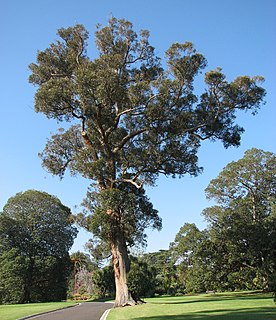
Eucalyptus muelleriana, commonly known as yellow stringybark, is a species of medium-sized to tall tree that is endemic to southeastern Australia. It has rough, stingy bark on the trunk and branches, lance-shaped to curved adult leaves, flower buds in groups of between seven and eleven, white flowers and cup-shaped to shortened spherical fruit.

Eucalyptus caliginosa, commonly known as broad-leaved stringybark or New England stringybark, is a tree that is endemic to eastern Australia. It has stringy bark, lance-shaped or curved adult leaves, flower buds in groups of seven or nine, white flowers and more or less hemispherical fruit. It is common on the Northern Tablelands and North West Slopes of New South Wales and adjacent areas of Queensland.

Eucalyptus rossii, commonly known as inland scribbly gum or white gum, is a species of small to medium-sized tree that is endemic to New South Wales and the Australian Capital Territory. It has smooth bark with insect scribbles, lance-shaped adult leaves, flower buds in groups of between nine and fifteen, white flowers and hemispherical or shortened spherical fruit.
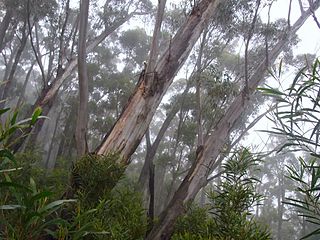
Eucalyptus stenostoma, commonly known as the Jillaga ash, is a small to medium-sized tree in that is endemic to a restricted part of New South Wales. It has rough, fissured bark on the lower trunk, smooth creamy white bark above, lance-shaped adult leaves, flower buds in groups of thirteen to nineteen or more, white flowers and spherical fruit with a small opening.

Eucalyptus triflora, commonly known as Pigeon House ash or three-flowered ash, is a species of small tree that is endemic to a small area of New South Wales. It has smooth bark, lance-shaped or curved adult leaves, flower buds usually in groups of three, white flowers and urn-shaped fruit.

Eucalyptus sieberi, commonly known as the silvertop ash or black ash, is a species of medium-sized to tall tree that is endemic to south-eastern Australia. It has rough bark on the trunk and the base of larger branches, smooth bark above, lance-shaped to curved adult leaves, flower buds in groups of seven to fifteen, white flowers and barrel-shaped or conical fruit.

Eucalyptus burgessiana, commonly known as the Faulconbridge mallee ash, is a small tree or mallee that is endemic to New South Wales. It has smooth bark, narrow lance-shaped or curved adult leaves, flower buds arranged in groups of between seven and eleven, white flowers and barrel-shaped or cup-shaped flowers.
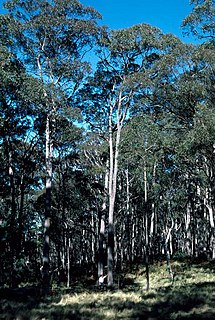
Eucalyptus laevopinea, commonly known as the silver top stringybark, is a tree that is endemic to eastern Australia. It has rough, stringy greyish bark on the trunk and larger branches, glossy green, lance-shaped adult leaves, flower buds in groups of between seven and eleven, white flowers and hemispherical or shortened spherical fruit.
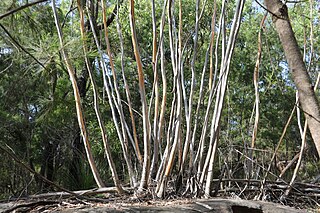
Eucalyptus multicaulis, commonly known as the whipstick mallee ash, is a species of mallee that is endemic to New South Wales. It has smooth bark, lance-shaped or curved adult leaves, oval to club-shaped flower buds in groups of between seven and fifteen, white flowers and conical fruit.

Eucalyptus moorei, commonly known as narrow-leaved sally, is a species of mallee that is endemic to New South Wales. It has smooth bark, linear to narrow lance-shaped or curved adult leaves, flower buds in groups of between seven and fifteen, white flowers and cup-shaped or shortened spherical fruit.

Eucalyptus ligustrina, commonly known as the privet-leaved stringybark, is a species of shrub, mallee or small tree that is endemic to New South Wales. It has rough, stringy bark, lance-shaped to egg-shaped adult leaves, flower buds in groups of between seven and fifteen, white flowers and hemispherical or shortened spherical fruit.
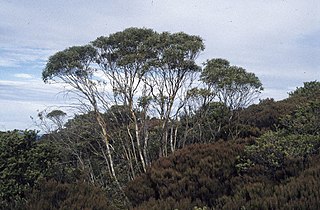
Eucalyptus kybeanensis, commonly known as the Kybean mallee ash, is a species of mallee or tree that is endemic to south eastern Australia. It has smooth, white or greyish bark, lance-shaped adult leaves, flower buds in groups of seven, nine or eleven, white flowers and conical or hemispherical fruit.
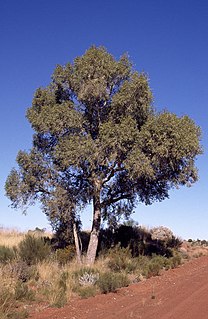
Corymbia chippendalei, commonly known as the sand-dune bloodwood or sandhill bloodwood, is a species of small tree or a mallee that is endemic to desert country in central Australia. It has rough bark on part or all of the trunk, lance-shaped adult leaves, flower buds in groups of seven, white flowers and shortened spherical fruit.
Eucalyptus remota, commonly known as the Kangaroo Island ash, Kangaroo Island mallee ash, or Mount Taylor mallee, is a species of tree or mallee that is endemic to Kangaroo Island in South Australia. It has smooth bark, often with rough, fibrous bark on the trunk, lance-shaped adult leaves, flower buds in group of between nine and twenty one, white flowers and hemispherical or shortened spherical fruit.
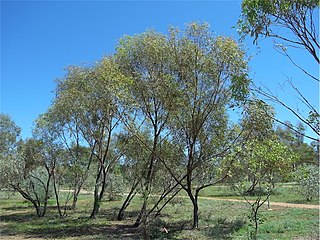
Eucalyptus normantonensis, commonly known as Normanton box, is a species of mallee, rarely a small tree, that is endemic to northern Australia. It has rough, fibrous or flaky bark on some or all of the stems, lance-shaped to curved adult leaves, flower buds in groups of between seven and eleven, white flowers and cylindrical, barrel-shaped or shortened spherical fruit.
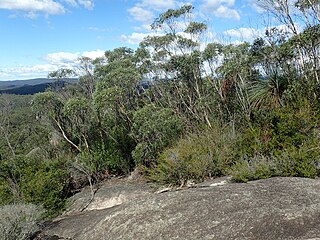
Eucalyptus codonocarpa, commonly known as the bell-fruited mallee ash or New England mallee ash, is a flowering plant that is endemic to eastern Australia. It is a slender mallee with smooth, grey, yellow or brownish bark, lance-shaped to curved adult leaves, flowers buds in groups of three or seven, white flowers and bell-shaped fruit. It grows on the Northern Tablelands in New South Wales and nearby areas in Queensland.
Eucalyptus longissima is a species of mallee or small tree that is endemic to the south-west of Western Australia. It has rough, fibrous or stringy bark on the trunk, smooth greyish brown bark above, glossy green, lance-shaped adult leaves, flower buds in group of between seven and thirteen, white flowers and shortened spherical fruit.


















